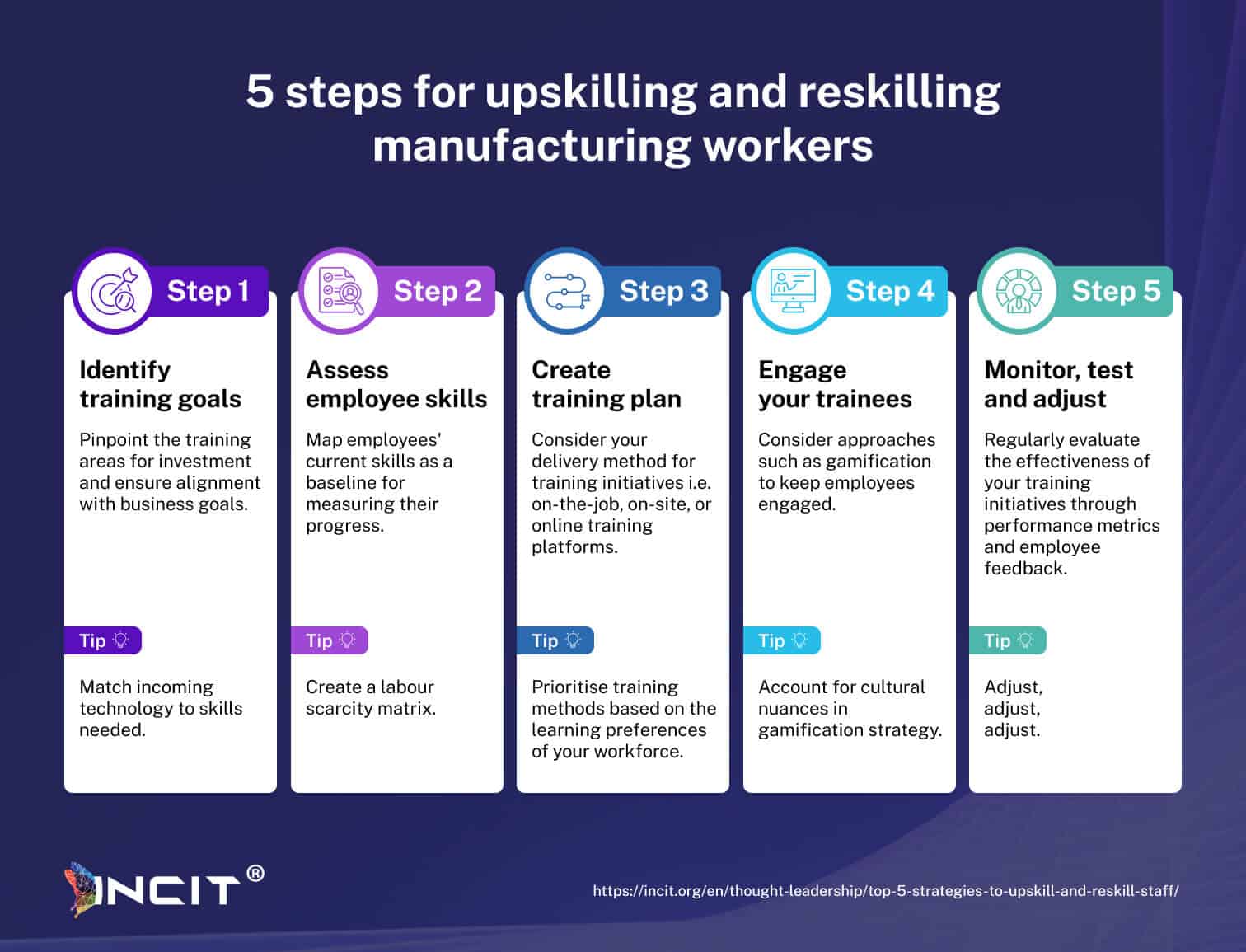这 significant skill gap in manufacturing continues to widen, as underscored by Deloitte’s research, which found that 2.1 million unfilled jobs will result in a cost of roughly $1 trillion to the United States in 2030 我们知道,当前和未来人才短缺的原因有很多,主要包括劳动力老龄化、技术进步但技能跟不上,以及对制造业角色的过时看法。 让人想起电影中描绘的危险、乏味的工作条件 美国小说家厄普顿·辛克莱的《丛林》。
根据 美国商会, 制造业仍有 45% 的职位空缺尚未填补。 世界经济论坛2023年就业前景展望 report highlights that 40 of the current skill requirements in advanced manufacturing are expected to evolve over the next five years. Leaders have sounded the alarm, according to a survey by the 全国制造商协会(NAM),近75%的制造业经理认为熟练劳动力短缺是他们面临的主要业务挑战。
Manufacturers are grappling with a significant labour shortage that demands urgent attention, but what can businesses do to prepare for the looming talent crisis? Below, we explore the key steps to put for empowering workers through targeted upskilling programs, ensuring resilience and growth in the face of workforce challenges.

通过战略性技能提升计划培养面向未来的劳动力
Labour shortages in the manufacturing sector are now endemic and expected to worsen. It is imperative for manufacturing companies to invest in upskilling and reskilling initiatives. By implementing targeted training programs aligned with evolving job roles and leveraging innovative methods like gamification (use it to make the reskilling more engaging!), manufacturers can empower their workforce to adapt, thereby alleviating labour shortfalls in the business. Embracing these strategies will not only bridge the skills gap but also position manufacturing firms for sustained growth and competitiveness in the global market.
此外,还有专门的培训项目,例如 西里/科西里 程序 offered by INCIT, can support leaders with their ongoing skill development with this certification, which advances digitalisation and sustainability practices within manufacturing. Embracing these strategies will not only bridge the skills gap but also position manufacturing firms for sustained growth and competitiveness in the global market.
Frequently Asked Questions About Upskilling and Reskilling in Manufacturing
What Are the 4 Strategies for Upskilling and Reskilling?
The four key strategies for upskilling and reskilling in manufacturing are:
- On-the-job training
- Digital learning platforms
- Industry-academic partnerships
- Certification programs
These approaches help workers gain new skills for smart manufacturing and Industry 4.0.
Why is Upskilling Important in Manufacturing?
Upskilling is important in manufacturing because it helps workers adapt to new technologies, improve productivity, and stay competitive in a rapidly changing Industry 4.0 environment.
What is the Difference Between Upskilling and Reskilling in Manufacturing?
Upskilling means learning new skills to grow in a current role, while reskilling involves training workers for entirely new roles. Both are essential in manufacturing to support digital transformation and automation.
How Can Manufacturers Create a Future-ready Workforce?
Manufacturers can create a future-ready workforce by investing in continuous training, embracing digital tools, building learning cultures, and aligning workforce development with Industry 4.0 technologies.
What Challenges Do Manufacturers Face in Workforce Training?
Manufacturers face challenges like limited training budgets, lack of digital literacy, ageing workforces, and difficulty keeping pace with fast-changing technologies in smart manufacturing.
What Are Examples of Upskilling in Smart Manufacturing?
Examples of upskilling in smart manufacturing include training workers to use robotics, data analytics tools, digital twins, IoT platforms, and AI-based production systems.
How Does Industry 4.0 Affect Workforce Planning?
Industry 4.0 affects workforce planning by shifting the demand toward tech-savvy roles, requiring new skills, and pushing manufacturers to rethink training, hiring, and talent retention strategies.
What Are the Best Practices for Workforce Transformation in Manufacturing?
Best practices for workforce transformation include skills gap assessments, personalised learning paths, leadership development, partnerships with tech providers, and performance tracking tied to Industry 4.0 goals.



